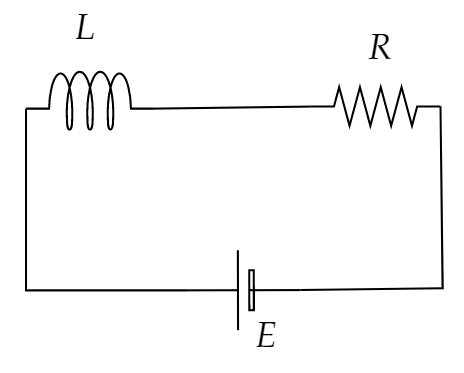
The time constant of a circuit is $10{\text{ }}\sec $, when a resistance of $10{\text{ }}\Omega $ is connected in series in a previous circuit then time constant becomes ${\text{2}}$ second, then the self-inductance of the circuit is:
A. $2.5{\text{ }}H$
B. $5{\text{ }}H$
C. ${\text{15 }}H$
D. ${\text{25 }}H$
Answer
475.8k+ views
Hint: Here it is given that the time constant of a circuit is $10{\text{ }}\sec $ when an inductor and a resistor are connected in a series. The time constant changes when another resistance is connected with it in series. Hence, we have to formulate equations using the relation between time constant, resistance and inductance. Then by comparing the equations we will find the answer.
Complete step by step answer:
It is given in the question that when a resistance and inductor are connected in series then the time constant is $10{\text{ }}\sec $.
Let the resistance of the circuit be $R$ and the inductance of the circuit be $L$

The relation between time constant $\tau = 2{\text{ }}\sec $, resistance $R$ and inductance $L$ is,
$\tau = \dfrac{L}{R} - - - - - \left( 1 \right)$
Substituting the value of $\tau $ we get,
$10 = \dfrac{L}{R}$
$ \Rightarrow L = 10R - - - - - \left( 2 \right)$
Again, it is given that a new resistance of $10{\text{ }}\Omega $ is connected in series with the circuit,
Thus, the new resistance of the circuit $R' = (10 + R){\text{ }}\Omega $
The new time constant is given as $\tau ' = 2{\text{ }}\sec $
The inductance remains the same $L$.

Thus, from equation $\left( 1 \right)$ we get,
$2 = \dfrac{L}{{10 + R}}$
$ \Rightarrow L = 20 + 2R - - - - - \left( 3 \right)$
Comparing equation $\left( 2 \right)$ and $\left( 3 \right)$ we get,
$10R = 20 + 2R$
$ \Rightarrow R = 2.5{\text{ }}\Omega $
Substituting the value of $R$ in equation $\left( 2 \right)$ we get,
$L = 2.5 \times 10 = 25{\text{ }}H$
Thus, the self-inductance of the coil is $25{\text{ }}H$.
The correct option is D. ${\text{25 }}H$.
Note: It must be noted that in this case self-inductance is developed as there is only one inductor. Self-inductance of a circuit is defined as the property of the coil by which an induced emf is developed in the coil due to the change in current flowing through it.
Complete step by step answer:
It is given in the question that when a resistance and inductor are connected in series then the time constant is $10{\text{ }}\sec $.
Let the resistance of the circuit be $R$ and the inductance of the circuit be $L$

The relation between time constant $\tau = 2{\text{ }}\sec $, resistance $R$ and inductance $L$ is,
$\tau = \dfrac{L}{R} - - - - - \left( 1 \right)$
Substituting the value of $\tau $ we get,
$10 = \dfrac{L}{R}$
$ \Rightarrow L = 10R - - - - - \left( 2 \right)$
Again, it is given that a new resistance of $10{\text{ }}\Omega $ is connected in series with the circuit,
Thus, the new resistance of the circuit $R' = (10 + R){\text{ }}\Omega $
The new time constant is given as $\tau ' = 2{\text{ }}\sec $
The inductance remains the same $L$.

Thus, from equation $\left( 1 \right)$ we get,
$2 = \dfrac{L}{{10 + R}}$
$ \Rightarrow L = 20 + 2R - - - - - \left( 3 \right)$
Comparing equation $\left( 2 \right)$ and $\left( 3 \right)$ we get,
$10R = 20 + 2R$
$ \Rightarrow R = 2.5{\text{ }}\Omega $
Substituting the value of $R$ in equation $\left( 2 \right)$ we get,
$L = 2.5 \times 10 = 25{\text{ }}H$
Thus, the self-inductance of the coil is $25{\text{ }}H$.
The correct option is D. ${\text{25 }}H$.
Note: It must be noted that in this case self-inductance is developed as there is only one inductor. Self-inductance of a circuit is defined as the property of the coil by which an induced emf is developed in the coil due to the change in current flowing through it.
Recently Updated Pages
Master Class 12 Economics: Engaging Questions & Answers for Success

Master Class 12 Maths: Engaging Questions & Answers for Success

Master Class 12 Biology: Engaging Questions & Answers for Success

Master Class 12 Physics: Engaging Questions & Answers for Success

Basicity of sulphurous acid and sulphuric acid are

Master Class 12 Business Studies: Engaging Questions & Answers for Success

Trending doubts
How much time does it take to bleed after eating p class 12 biology CBSE

Explain sex determination in humans with line diag class 12 biology CBSE

Differentiate between homogeneous and heterogeneous class 12 chemistry CBSE

When was the first election held in India a 194748 class 12 sst CBSE

Explain sex determination in humans with the help of class 12 biology CBSE

December 10th of 1948 is an important day in the history class 12 sst CBSE




